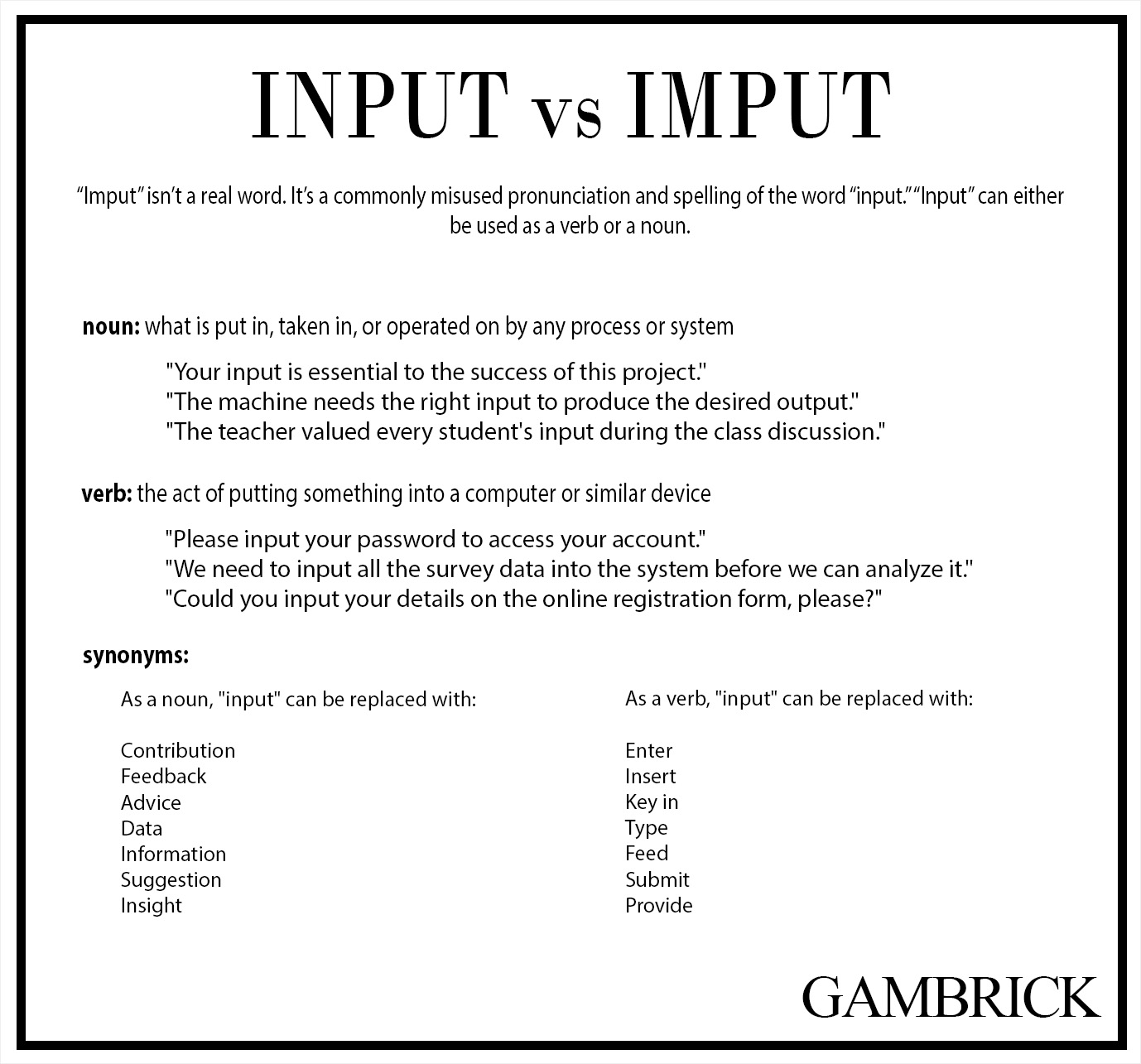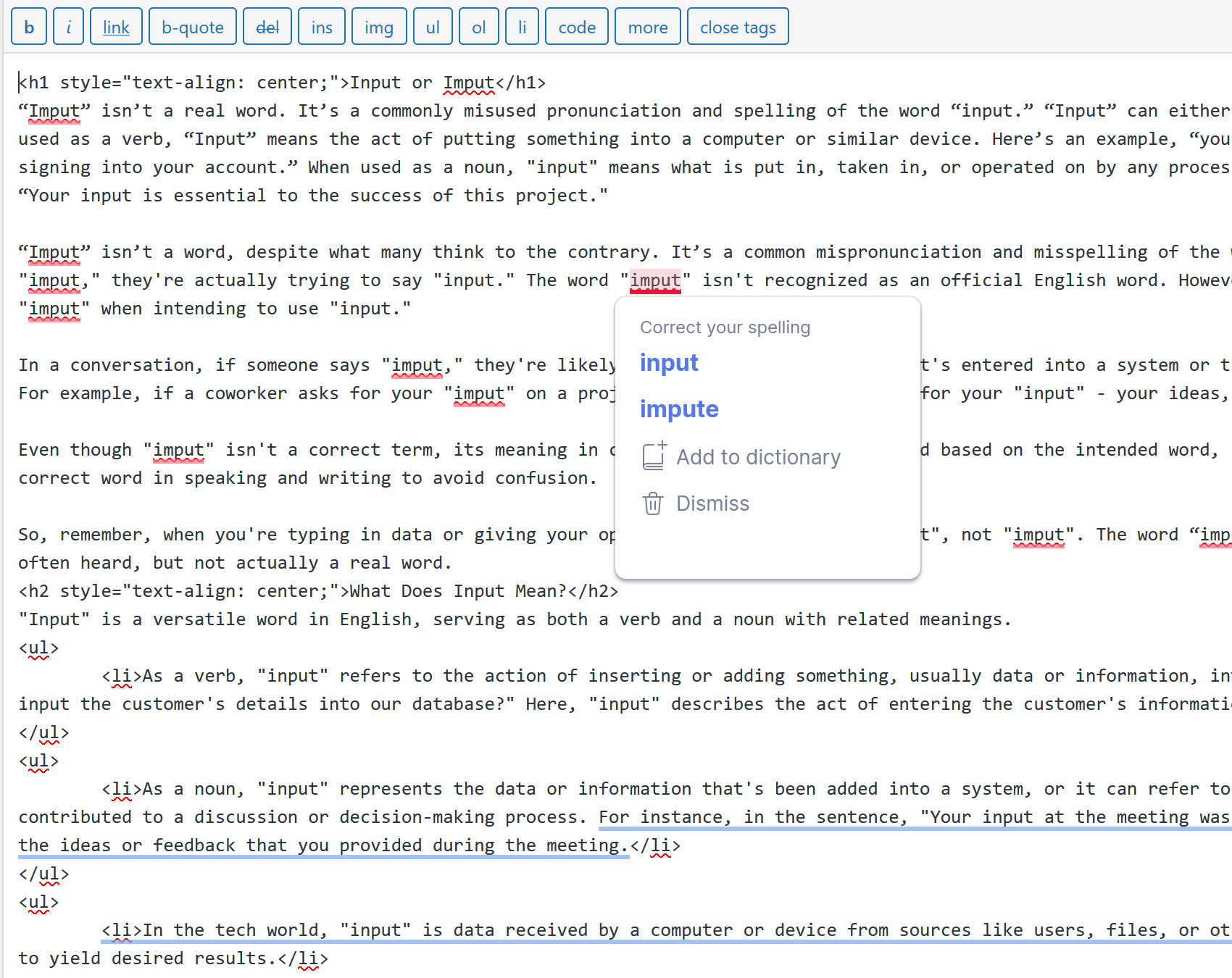Input or Imput
“Imput” isn’t a real word. It’s a commonly misused pronunciation and spelling of the word “input.” “Input” can either be used as a verb or a noun. When used as a verb, “Input” means the act of putting something into a computer or similar device. Here’s an example, “you must “input” a password when signing into your account.” When used as a noun, “input” means what is put in, taken in, or operated on by any process or system. Here’s an example, “Your input is essential to the success of this project.” When deciding between using “input” or “imput” in both speech and writing, the correct answer is always “input”. The only exceptions are when you’re quoting someone or using slang.
“Imput” isn’t a word, despite what many think to the contrary. It’s a common mispronunciation and misspelling of the word “input”. When people say “imput,” they’re actually trying to say “input.” The word “imput” isn’t recognized as an official English word. However, it’s a common mistake to use “imput” when intending to use “input.”
In a conversation, if someone says “imput,” they’re likely referring to information that’s entered into a system or their contribution to a discussion. For example, if a coworker asks for your “imput” on a project, they’re actually asking for your “input” – your ideas, suggestions, or feedback.
Even though “imput” isn’t a correct term, its meaning in context is typically understood based on the intended word, “input.” But it’s best to use the correct word in speaking and writing to avoid confusion.
So, remember, when you’re typing in data or giving your opinion, you’re providing “input”, not “imput”. The word “imput” is considered a ghost word – often heard, but not actually a real word.
What Does Input Mean?
“Input” is a versatile word in English, serving as both a verb and a noun with related meanings.
- As a verb, “input” refers to the action of inserting or adding something, usually data or information, into a system. For example: “Could you input the customer’s details into our database?” Here, “input” describes the act of entering the customer’s information into the system.
- As a noun, “input” represents the data or information that’s been added into a system, or it can refer to ideas, opinions, or feedback contributed to a discussion or decision-making process. For instance, in the sentence, “Your input at the meeting was very helpful,” “input” refers to the ideas or feedback that you provided during the meeting.
- In the tech world, “input” is data received by a computer or device from sources like users, files, or other programs. The data is processed to yield desired results.
- In linguistics, “input” signifies all forms of communication we use to interact with others.
- In psychology, it refers to various sensory stimuli we experience in our environment.
- When used as a noun, “input” describes anything added to a system – be it energy, money, or information – to make it work. It’s also the part that sends data to a machine or its connection point.
- As a verb, “input” means entering data into a computer or electronic device.
In both its forms, “input” plays a significant role in our digital, data-driven age and in collaborative discussions where diverse opinions and ideas are valued.
Input is a Noun
“Input” as a noun, refers to the data, information, ideas, or resources that are added or fed into a system or process. It’s a key term in fields such as computing, business, and communication.
For instance, in a computer system, an “input” could be the text you type into a search engine or the click you make with your mouse. In a business meeting, your “input” could be the suggestions or feedback you provide for a project discussion.
“Inputs” is the plural form of “input” and it’s used when referring to multiple instances of data, information, or resources. For example, in manufacturing, the “inputs” can be the raw materials used to produce a product. In a brainstorming session, the “inputs” could be the various ideas shared by team members.
The word “input” in its noun form denotes anything that’s put into a system or process, with its exact meaning depending on the context.
Seven sentences using “input” as a noun:
- “Your input is essential to the success of this project.”
- “The machine needs the right input to produce the desired output.”
- “The teacher valued every student’s input during the class discussion.”
- “Without the correct input, the software can’t function properly.”
- “The survey is designed to gather input from all employees about the new policies.”
- “His input was instrumental in making the event a success.”
- “We’ve considered all the input we received during the public hearing before making our decision.”
Input is a Verb
“Input” as a verb refers to the action of adding or inserting data, information, or resources into a system or process.
For example, in the context of computer usage, you “input” your password to log into an account. In a brainstorming session, you might “input” your ideas by sharing them with the group.
The past tense of “input” can be either “inputted” or “input,” though the latter is more commonly used. For instance, you might say, “Yesterday, I input (or inputted) the necessary data into the spreadsheet.”
There’s no plural form for “input” as a verb, as verbs don’t typically have a plural form in English. However, it can be conjugated in different tenses, like “inputs” (present tense), “inputting” (present participle), and “input” or “inputted” (past tense and past participle).
In essence, to “input” is to add or insert something into a system, and it can be applied to various contexts, including computing, business discussions, and more.
Seven sentences using “input” as a verb:
- “Please input your password to access your account.”
- “We need to input all the survey data into the system before we can analyze it.”
- “Could you input your details on the online registration form, please?”
- “Before printing the document, I need to input the correct margins and format.”
- “The programmer inputted the new code to improve the app’s performance.”
- “She spent hours inputting patient records into the hospital’s new database.”
- “During the meeting, the manager asked everyone to input their ideas into the shared document.”
Input Vs Imput
“Imput” is not a word. When you hear it, it’s most likely a mispronunciation of “input”. As you can see from the picture above, a spell check will flag every use of the word “imput” and will suggest changing it to either “input” or “impute”. Since “impute” has an entirely different meaning, the correct change is “input”.
“Input” is a versatile word with a straightforward meaning: to add something. It’s used in many ways and contexts. Imagine you’re filling out a form on a computer; you’re inputting data. Here, “input” is a verb describing the action of adding information.
“Input” can also denote a contribution. Let’s say you’re brainstorming for a project, and you share an idea. You’ve just input your ideas into the discussion.
As a noun, “input” represents anything that’s added, like data, information, or ideas. So, in a nutshell, “input” means anything added or inserted, and its use varies with context.
Now, don’t confuse “imput” with “impute,” which is a real word but means something entirely different. “Impute” can mean assigning blame to someone or attributing value to something. It’s entirely unrelated to the concept of “input”.
How Do You Use the Word Input?
“Input” is a versatile English word used both as a verb and a noun. As a verb, “input” means adding or inserting something, typically into a system or a discussion. For instance, “Please input your password to log in.” or “She input her suggestions into the meeting.”
As a noun, “input” refers to the information or data added into a system or contributions in a discussion. For example, “The machine needs the correct input to work.” or “His input in the brainstorming session was valuable.”
In essence, “input” revolves around the idea of adding or contributing something, whether it’s data, information, or ideas. Its usage varies depending on the context.
Are There Words Synonymous With The Term Input?
Synonyms are words that share the same meaning. They’re a vital tool in communication, enabling us to express ourselves with greater ease. Synonyms help reduce ambiguity, promoting clearer, more precise dialogue and writing. To help you grasp the synonyms of “input” more effectively, here’s a table for your reference.
There are several synonyms for “input,” although the best choice depends on the context. Here are a few examples:
As a noun, “input” can be replaced with words like:
- Contribution
- Feedback
- Advice
- Data
- Information
- Suggestion
- Insight
As a verb, “input” can be replaced with:
- Enter
- Insert
- Key in
- Type
- Feed
- Submit
- Provide
Again, remember to choose the synonym that best fits the context of your sentence.
Is It Correct To Say Inputs?
Indeed, “inputs” is the correct plural form of “input.” It’s used to describe multiple items or pieces of information entered into a system or multiple opinions in a discussion.
“Inputs” often refers to the information a computer needs to function. It could be data the computer reads or processes.
The term also applies to resources a machine requires to generate outputs. Consider a printer: it requires text (digital data) and ink to print a document. Here, the text and ink are the “inputs,” making your printed document the “output”.
What’s The Difference Between Input & Output?
“Input” and “output” are central concepts in computing. “Input” signifies the raw data fed into a computer, like keystrokes from a keyboard or signals from sensors. This data is transmitted to the computer’s Central Processing Unit (CPU) and stored in memory.
“Output,” on the other hand, is the result a computer produces after processing input. It can appear on a screen or be transmitted to other devices.
These concepts often intertwine as computers can simultaneously input data and generate output.
Understanding the difference is simple: “input” goes into the computer, while “output” comes out. But remember, both are crucial for computing operations.
For example, when you type a query into a search engine (input), the search results you see are the output. Good input and output systems maximize a computer’s efficiency.
Conclusion
“Input” can be a noun or a verb, indicating something added or the act of adding. However, “Imput” is a mispronounced version of “input” and is grammatically incorrect.
Mistakes in pronunciation are common, so don’t fret about improving.
“Input” is the right term. Although some might incorrectly say “imput,” always remember to use “input” when referring to data or information entered into a system.
“Input” could be data, instructions, or even energy fed into a system to achieve a specific result. It can be a noun or a verb, and its meaning varies with context. Knowing these diverse uses will enhance your usage of the word. Practice incorporating “input” in your sentences.
It’s also correct to use “inputs.” For instance, in nutrition, “inputs” are what we consume for growth and health. It’s crucial we make the right choices.
In essence, “input” is what you feed into a system, and “output” is the result. “Input” can be data, energy, or personnel, while “output” could be work performed, heat generated, or products made.
Summary: Input or Imput: Which Is Correct?
“Imput” isn’t a real word. It’s a commonly misused pronunciation and spelling of the word “input.” “Input” can either be used as a verb or a noun. When used as a verb, “Input” means the act of putting something into a computer or similar device. Here’s an example, “you must “input” a password when signing into your account.” When used as a noun, “input” means what is put in, taken in, or operated on by any process or system. Here’s an example, “Your input is essential to the success of this project.”
“Imput” isn’t a word, despite what many think to the contrary. It’s a common mispronunciation and misspelling of the word “input”. When people say “imput,” they’re actually trying to say “input.” The word “imput” isn’t recognized as an official English word. However, it’s a common mistake to use “imput” when intending to use “input.”
In a conversation, if someone says “imput,” they’re likely referring to information that’s entered into a system or their contribution to a discussion. For example, if a coworker asks for your “imput” on a project, they’re actually asking for your “input” – your ideas, suggestions, or feedback.
Even though “imput” isn’t a correct term, its meaning in context is typically understood based on the intended word, “input.” But it’s best to use the correct word in speaking and writing to avoid confusion.
So, remember, when you’re typing in data or giving your opinion, you’re providing “input”, not “imput”. The word “imput” is considered a ghost word – often heard, but not actually a real word.
If you have any questions or comments about “input” vs. “imput”, email any time.























